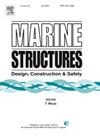Static load-bearing capacity of tubular K-joints reinforced with collar plates under axial loading
IF 5.1
2区 工程技术
Q1 ENGINEERING, CIVIL
引用次数: 0
Abstract
This study investigates the static load-bearing performance of tubular K-joints (TKJs) reinforced with collar plates under axial loading. A detailed finite element model was developed incorporating 3D solid elements, weld geometry, contact nonlinearity, and both material and geometric nonlinear behavior. The model was validated against available experimental data, demonstrating excellent agreement. A comprehensive parametric study was then carried out on 128 tubular joints reinforced with collar plate (RTJs) to evaluate the influence of key dimensionless geometric parameters—such as brace-to-chord diameter ratio (β), chord slenderness ratio (γ), gap-to-chord diameter ratio (ζ), collar thickness ratio (δ = collar thickness to chord thickness), collar length ratio (ω = collar length to brace diameter), and brace inclination (θ)—on joint performance. Results show that the effectiveness of the reinforcement strongly dependent on geometry. Additionally, a nonlinear regression model based on yield volume theory was proposed to predict the reinforcement index (Φ), defined as the capacity ratio between RTJs and their unreinforced counterparts. The proposed formula provides a reliable tool for the design and evaluation of collar-reinforced tubular joints under axial loading.
轴向载荷作用下带接箍板的k形管节点静承载力研究
本文研究了轴向载荷作用下带接箍板的管状k形节点的静力承载性能。建立了包含三维实体单元、焊缝几何、接触非线性以及材料和几何非线性行为的详细有限元模型。该模型与现有的实验数据进行了验证,证明了良好的一致性。对128个带箍板加固的管状节点进行了综合参数化研究,评估了关键的无量因几何参数——箍与弦径比(β)、弦长细比(γ)、间隙与弦径比(ζ)、箍厚比(δ =箍厚与弦厚)、箍长比(ω =箍长与托径)和箍斜(θ)对节点性能的影响。结果表明,加固效果与几何形状有很大关系。此外,提出了基于屈服体积理论的非线性回归模型来预测加固指数(Φ),定义为钢筋混凝土与未加固混凝土的容量比。该公式为轴向载荷作用下箍筋管状节点的设计与评价提供了可靠的工具。
本文章由计算机程序翻译,如有差异,请以英文原文为准。
求助全文
约1分钟内获得全文
求助全文
来源期刊

Marine Structures
工程技术-工程:海洋
CiteScore
8.70
自引率
7.70%
发文量
157
审稿时长
6.4 months
期刊介绍:
This journal aims to provide a medium for presentation and discussion of the latest developments in research, design, fabrication and in-service experience relating to marine structures, i.e., all structures of steel, concrete, light alloy or composite construction having an interface with the sea, including ships, fixed and mobile offshore platforms, submarine and submersibles, pipelines, subsea systems for shallow and deep ocean operations and coastal structures such as piers.
 求助内容:
求助内容: 应助结果提醒方式:
应助结果提醒方式:


